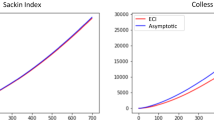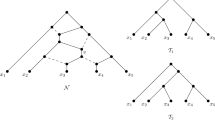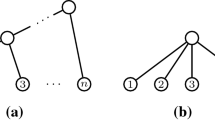Abstract
Trees with a coloration of their leaves have an induced “length” which forms the basis of the widely used maximum parsimony method for reconstructing evolutionary trees in biology. Here we describe five unexpected properties of this length function, including refinements of earlier results.
Similar content being viewed by others
Literature
Archie, J. W. and J. Felsenstein. 1993. The number of evolutionary steps on random and minimum length trees for random evolutionary data.Theor. Pop. Biol. 43, 52–79.
Bondy, J. A. and U. S. R. Murty. 1976.Graph Theory with Applications. Macmillan, London.
Cavender, J. 1978. Taxonomy with confidence.Math. Biosci. 40, 271–280.
Erdös, P. L. and L. A. Székely. 1992. Evolutionary trees: an integer multicommodity max-flow-min-cut theorm.Adv. appl. Math. 13, 375–389.
Felsenstein, J. 1988. Phylogenies from molecular sequences: inference and reliability.Ann. Rev. Genet. 22, 521–565.
Fitch, W. M. 1971. Toward defining the course of evolution: minimum change for a specific tree topology.Syst. Zool. 20, 406–416.
Goloboff, P. A. 1991. Homoplasy and choice among cladograms.Cladistics 7, 215–232.
Goulden, I. P. and D. M. Jackson. 1983.Combinatorial Enumeration. Wiley, New York.
Hartigan, J. A. 1973. Minimum mutation fits to a given tree.Biometrics 29, 53–65.
Maddison, W. P. and M. Slatkin. 1991. Null models for the number of evolutionary steps in a character on a phylogenetic tree.Evolution 45, 1184–1197.
Steel, M. A. 1989. Distributions in bicoloured evolutionary trees. Ph.D. thesis. Massey University, Palmerston North, New Zealand.
Steel, M. A. 1993 Distributions on bicolored binary trees arising from the principle of parsimony.Discrete Appl. Math. 41, 245–261.
Author information
Authors and Affiliations
Rights and permissions
About this article
Cite this article
Steel, M., Charleston, M. Five surprising properties of parsimoniously colored trees. Bltn Mathcal Biology 57, 367–375 (1995). https://doi.org/10.1007/BF02460622
Received:
Accepted:
Issue Date:
DOI: https://doi.org/10.1007/BF02460622




